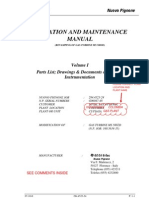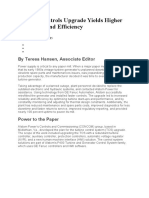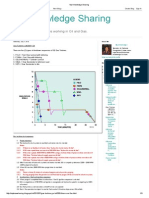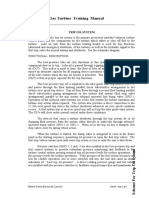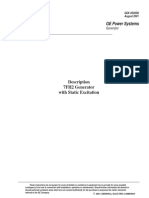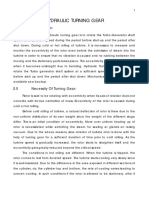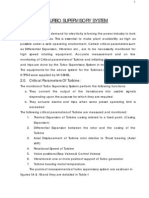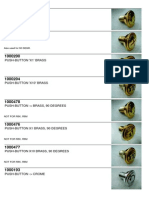89%(9)89% found this document useful (9 votes)
3K viewsShaft Turning Gear
Shaft Turning Gear
Uploaded by
Jagadeesan SaiThe document discusses the hydraulic turning gear system used to slowly rotate turbine generator shafts before startup and after shutdown. This helps reduce eccentricity in the rotor from uneven heating and cooling. The system works by supplying high pressure oil through nozzles to blades connected to the shaft, rotating it at 120-160 rpm. It also describes the mechanical barring gear backup system and hydraulic lifting devices that maintain an oil film between the rotor and bearings during low-speed rotation to prevent damage.
Copyright:
© All Rights Reserved
Available Formats
Download as PDF, TXT or read online from Scribd
Shaft Turning Gear
Shaft Turning Gear
Uploaded by
Jagadeesan Sai89%(9)89% found this document useful (9 votes)
3K views22 pagesThe document discusses the hydraulic turning gear system used to slowly rotate turbine generator shafts before startup and after shutdown. This helps reduce eccentricity in the rotor from uneven heating and cooling. The system works by supplying high pressure oil through nozzles to blades connected to the shaft, rotating it at 120-160 rpm. It also describes the mechanical barring gear backup system and hydraulic lifting devices that maintain an oil film between the rotor and bearings during low-speed rotation to prevent damage.
Original Description:
SHAFT TURNING GEAR
Original Title
SHAFT TURNING GEAR
Copyright
© © All Rights Reserved
Available Formats
PDF, TXT or read online from Scribd
Share this document
Did you find this document useful?
Is this content inappropriate?
The document discusses the hydraulic turning gear system used to slowly rotate turbine generator shafts before startup and after shutdown. This helps reduce eccentricity in the rotor from uneven heating and cooling. The system works by supplying high pressure oil through nozzles to blades connected to the shaft, rotating it at 120-160 rpm. It also describes the mechanical barring gear backup system and hydraulic lifting devices that maintain an oil film between the rotor and bearings during low-speed rotation to prevent damage.
Copyright:
© All Rights Reserved
Available Formats
Download as PDF, TXT or read online from Scribd
Download as pdf or txt
89%(9)89% found this document useful (9 votes)
3K views22 pagesShaft Turning Gear
Shaft Turning Gear
Uploaded by
Jagadeesan SaiThe document discusses the hydraulic turning gear system used to slowly rotate turbine generator shafts before startup and after shutdown. This helps reduce eccentricity in the rotor from uneven heating and cooling. The system works by supplying high pressure oil through nozzles to blades connected to the shaft, rotating it at 120-160 rpm. It also describes the mechanical barring gear backup system and hydraulic lifting devices that maintain an oil film between the rotor and bearings during low-speed rotation to prevent damage.
Copyright:
© All Rights Reserved
Available Formats
Download as PDF, TXT or read online from Scribd
Download as pdf or txt
You are on page 1of 22
At a glance
Powered by AI
The key takeaways are that a hydraulic turning gear is used to slowly rotate the turbine rotor before startup and after shutdown to reduce eccentricity and ensure smooth operation. It helps equalize temperatures in the rotor and prevents thermal stresses and bending.
The purpose of a hydraulic turning gear is to rotate the turbo-generator shaft system at a sufficient speed during the period before start-up and after shut down. This is to measure and monitor the eccentricity of the rotor and ensure no vibration or rubbing occurs.
It is necessary to rotate the turbine rotor after shutdown to prevent uneven cooling from causing thermal stresses, bending and eccentricity in the rotor. Slow rotation helps equalize temperatures between the top and bottom of the cylinder.
1
HYDRAULIC TURNING GEAR
1.0 Introduction:
The function of hydraulic turning gear is to rotate the Turbo-Generator shaft
system at a sufficient speed during the period before start-up and the period after
shut down. During cold or hot rolling of turbine, it is necessary to measure and
monitor the eccentricity of the rotor even before the admission of steam into the
turbine in order to ensure that no vibration is caused and no rubbing between the
moving and the stationary parts takes place. The eccentricity of the rotor is caused
when it becomes unstraight due to bending. Hydraulic Turning gear is useful to
rotate the Turbo generator shaft system at a sufficient speed during the period
before start up and the period after shut down. Mechanical Barring gear is also
available as a backup.
2.0 Necessity Of Turning Gear:
Rotor is said to be rotating with eccentricity when its axis of rotation does not
coincide with its true centerline of mass. Eccentricity of the rotor is caused during
cold or hot rolling.
Before cold rolling of turbine, a natural deflection of rotor is there due to the
non-uniform distribution of its own weight since the weight of the different stage
differ. This is an initial condition of eccentricity. More over uniform heating up of
rotor is necessitated while admitting the steam for sealing at glands on raising
vacuum. Due to the above reasons, slow rotation of turbine rotor is done with the
help of turning gear for a sufficient duration of time prior to cold rolling. As the
turbine speed is gradually increased, the rotor starts to straighten itself and the
eccentricity gets greatly reduced beyond the critical speed.
The conditions in hot rolling are different. When the turbine is tripped, the
rotor comes to rest from its rated speed. The turbine starts cooling very slowly since
it is well insulated. Due to the difference in the area exposed in different sections of
the cylinder, viz. the cylinder top and bottom, the rate of cooling varies leading to
uneven cooling. In such conditions if the rotor is allowed to be stationary, after it
2
comes to rest, it would be exposed to uneven temperatures, resulting in thermal
stresses, bending and eventually eccentricity in the rotor. This problem is also
overcome by having a slow rotation of rotor by means of turning gear. The blade
ventilation during turning operation provides good heat transfer at the inner wall of
the casing, which is conducive for temperature equalization between the top and
the bottom cylinder.
3.0 Hydraulic Turning Gear:
Hydraulic turning gear is located in the bearing pedestal between IP turbine
and the HP turbine. Mechanical barring gear is available as a back up to this.
During turning gear operation, the turbo-generator shaft system is rotated by
a double row blade wheel, which is driven by oil. The oil is supplied by the auxiliary
oil pump and it flows through a gate valve gearing and a nozzle box. Gate valve
gearing is an electrically operated valve through which the high pressure oil is
supplied to turning gear thro Nozzle box. Nozzles guide the jet of oil towards the
moving blades. Nozzles increase the velocity of oil and guide the jet of oil towards
the moving blades. This flow of high velocity jet of oil through the two rows of
moving blades result in slow rotation of the Turbo generator rotor system. Speed of
rotation of TG rotor during the turning gear operation is 120 rpm without condenser
vacuum and 160 rpm with condenser vacuum.
In order to reduce the gap losses at the moving blades, sealing strips are
caulked into the nozzle boxes. After passing through the moving blades, the oil
drains into the bearing pedestal and flows along with the bearing drain oil into the
return flow piping.
To overcome the initial breakaway torque on startup and to prevent dry
friction, the bearings are relieved for a short time by jacking oil supplied below the
shaft. The shafts are thus slightly.
3
4.0 Mechanical Barring Gear:
The turbo generator is also equipped with a mechanical barring gear, which
enables the combined shaft system to be rotated manually in the event of failure
of the normal hydraulic turning gear.
4.1 Construction:
The mechanical barring gear consists of a gear machined on the rim of the
turning gear wheel and a pawl. The pawl engages with the ring gear and turns the
shaft system when operated by means of a bar attached to a lever. The pawl can
be engaged or disengaged by using a lever. The lever is held in position by means
of a latch.
4 4
5
Fig.No.1a HYDRAULIC TURNING GEAR & MANUAL BARRING GEAR
6 6
7
4.2 Operation of STG:
The following steps of operation are to be made
Remove the cover and unlatch,
Attach a bar to the lever,
Barring of lever will rotate the combined turbo-generator shaft system.
After the barring has been completed return the lever and the pawl to
disengaged position.
Secure the lever by means of latch and replace the cover.
The barring gear shall be operated only after the turbo-generator shaft
system has been lifted with jacking oil. If it is hard to start turning by means of the
mechanical barring gear, this may be due to incorrect adjustment of the jacking oil
system or due to rubbing of the shaft. Corrective action must be taken before the
steam is admitted into turbine. After shut down of turbine, turning gear should be in
operation till the maximum metal temperature reaches 120 C.
5.0 Hydraulic Lifting Device:
When the turbine is started up or shut down, the hydraulic lifting device is
used to maintain the oil film between rotor and bearings. The necessary torque for
rotation is reduced in this way when the hydraulic device or manual turning device
is in service.
The turbo-generator bearings are supplied with high-pressure oil delivered by
a jacking oil pump. The high pressure oil lifts the rotor when it is forced under the
journal of the bearings. To avoid damage to the bearings, the jacking oil pump
must be switched ON at turbine speed below 510 RPM. (approximately) during shut
down and it should be switched OFF at turbine speed above 540 RPM.
(approximately) during start-up.
5.1 Need Of The Jacking Oil For Lifting:
The way in which liquids lubricate can be explained by considering the
example of a plain journal bearing as shown in fig no.4.
As the shaft (journal) rotates in the bearing, lubricating oil is dragged into the
loaded zone. Since the loaded zone will be the point at which the shaft and the
8
bearing surfaces are closet together, the entry into this zone is tapered, like a
curved wedge. As the oil is forced to move into the narrower part of the wedge, its
pressure increases, and it is this hydrodynamic pressure which supports the shaft
load.
Increasing load reduces the oil film thickness while increasing hydrodynamic
pressure increases the oil film thickness. The hydro dynamic pressure, in turn, is
determined by the viscosity of the oil and the speed at which it is squeezed into the
wedge shaped entry zone. Thus the rise in hydrodynamic pressure and therefore
the thickness of the film will depend on the shaft speed and the lubricant viscosity.
The relationship between speed, viscosity, load, film thickness and friction
can be understood by considering a graph shown in fig no.4. In this graph, the co-
efficient of friction is plotted against expression V/P where, V/P = (Oil viscosity *
Shaft speed)/ Bearing pressure.
There are three different zones in the graph, separated by the points A & B.
At B, the co-efficient friction is at its minimum, and this is the point at which
the oil film is just thick enough to ensure that there is no contact between the shaft
and the bearing surfaces. The zone 3, to the right of B, the oil film thickness is
increasing and the co-efficient of friction also increases (as the film thickness
increases). This increase in the oil film thickness is because of increasing viscosity or
increasing shaft speed or reducing the bearing load. Zone 3 is the zone of
hydrodynamic lubrication or Full film lubrication.
As the conditions change from B towards A, the oil film thickness reduces
and hence the shaft and the bearing rub against each other, the amount of
rubbing, and the friction increases as the oil film thickness decreases, zone 2,
between A & B, is known as the zone of mixed lubrication or partial lubrication. The
shaft load was supported by a mixture of oil pressure and surface contacts,
At A, the oil film thickness has been reduced to nil and the load between
shaft and bearing is carried entirely on surface contact. In zone1, the co-efficient of
friction is almost independent of load, viscosity and shaft speed. Zone1 is the zone
of boundary lubrication.
9
10
The different lubrication zones also have an influence on wear, the amount
of wear which takes place depends on the severity with which two surfaces rub
against each other. In zone 3, there is no contact between the surfaces and
therefore the wear is minimum. As the oil film thickness becomes thinner in zones 2
and 1, there is a greater tendency to wear.
When the turbine is on Turning Gear during start-up or shut down, the shaft
speed is much less compared to its normal operating speed. Hence the shaft
rotates in the region of boundary lubrication. Since the oil film thickness is minimum
during low shaft speed, there is increasingly severe contact between the shaft and
the bearing surface resulting in increased wear and reduction in life of the bearing.
To avoid this, a jacking oil system also known as hydraulic lifting device is
necessitated to supply high pressure oil called as jacking oil under the journal of the
bearing thereby slightly lifting the journal. Slow rotation of turbine rotor during
turning operation is thus done in slightly lifted condition so as to avoid damage to
the bearings. Hence the shaft rotates now in the region of Hydrodynamic
lubrication.
5.2 Jacking Oil System:
To supply the high-pressure oil for the lifting device, two jacking oil
pumps of each 100% capacity are provided on the main oil tank. When one pump
is intended to be in service, the other one is stand by.
5.2.1 Jacking Oil Pump:
The jacking oil pump is a self-priming screw spindle pump with three spindles
and internal bearings. The screw spindle pump is connected vertically to the cover
plate (2) of the Main oil tank via a support (5) and immerses with the suction casing
(15) into the oil. The drive is an electric motor that is bolted to the cover plate. The
oil flows into the suction branch of the suction casing from underneath and is
supplied to the jacking oil system by the pump via the pressure pipe (3).
The driving spindle (16) and the two moving spindles (20) run in the inner
casing (13). Due to the special profile given by the sides of the threads, the three
spindles form-sealed chambers, the contents of which are continuously being
11
moved axially from the suction side to the pressure side of the pump as the spindles
rotate.
There is a balancing piston in the form of a shrunk on sleeve in the main drive
spindle just above the screwed portion of the main drive spindle and this runs inside
the throttle bushing (11). Pressure oil of a small quantity flows in a very small gap
between the throttle bushing (11) and the driving spindle (16) in an upward
direction. This gap is known as throttling gap since the pressure of oil which is
coming out of this gap is very much reduced. The oil that leaves the throttle gap
flows via the grooved ball bearing (7) and lubricates it. This bearing serves as both
support and thrust bearing. There after the oil flows through the support to the main
oil tank itself via an opening in the support. The driving spindle is fixed by means of
the grooved ball bearing in the bearing carrier (9) that is bolted to the pressure
casing (12) of the pump. The drive main spindle is a solid one. The cumulative axial
thrust generated by the main drive spindle screw is countered by the balancing
piston in the form of the shrunk on sleeve. The p across the balance piston and the
annular area of it are so designed to match with the cumulative axial thrust
generated by the main drive spindle.
There are two idler screw spindles, which are hollow and are driven by the
main drive spindle whose continuous helical screw is in mesh with the continuous
helical screws of them. Pressure oil in a very small quantity flows via gaps in the top
of the screwed portion of the main drive spindle though the hollow spaces of the
two idler screw spindles in a downward direction.
The two idler screw spindles also exert a cumulative axial thrust in a
downward direction, which are to be balanced, to perform this task, each idler
screw spindle is having a balancing bushing (21) in its bottom. These are fixed to the
support plate (18), which also supports the inner casing (13) by means of distance
pipes (17) attached to it. The balancing bushing has a small piston with a guide pin
in its bottom and can move only in a vertical direction in a small cylinder, which is
open in its top. The piston is located just below the ending point of the continuous
12
Fig. No. 5 Jacking oil pump
helical screw of the idler spindle. Pressure oil is supplied in the bottom of the piston
via hollow space of the idler spindle through a small opening. The top of the piston
is exposed to pressure less oil in the tank. The upward counter thrust provided by the
balance piston in the balancing bushing encounters the cumulative axial thrust
exerted by the continuous helical screw of each one of the idler spindle screws in
the downward direction. There is provision for leakage oil to escape to the main oil
tank from the balancing bushing on the pressure side.
13
5.2.2 Jacking Oil Supply: Ref fig no.6.
The discharge pressure oil piping of both the jacking oil pumps is connected
in parallel to supply high-pressure oil to the common jacking header. In each
discharge line, a check valve is provided to prevent the jacking oil returning from
the header to the oil tank, if the pump concerned is not in operation. A spring
loaded safety relief valve is provided between the jacking oil pump and the check
valve. This is to prevent any damage to the jacking oil pumps discharge piping in
case that the concerned jacking oil pump is in operation and the check valve
continues to remain in closed position.
The pressure in the common jacking oil header is maintained at a constant
value (approximately 120 bar) by means of a pressure-limiting valve. The pressure-
limiting valve can be relieved by a bypass valve. The superfluous flow from the
pump is conducted into the main oil tank.
The jacking oil required for each bearing is supplied from the common
header as detailed below.
Bearing No of lines
Hp front One
Hp Rear journal cum thrust One
IP Rear Two
LP Rear Two
Generator Front Two
Generator Rear One
In each supply line, a fine control valve and a check valve are provided. The
necessary jacking oil pressure sufficient to lift the shaft varies with respect to bearing
load. The lift will be of 0.03 to 0.05 mm. The required jacking oil pressure is set for
each bearing by means of a finer control valve. The pressure gauges mounted in
the downstream pipes of these finer control valves indicate the jacking oil pressure
required for lifting. A check valve provided in the jacking oil supply pipings prevent
14
Fig.No.6 Jacking oil system
the lub oil from flowing out of the bearings into the header during the normal
operation of turbine since the jacking oil pumps are out of service.
The finer control valve, the check valve and the pressure gauge for each line
are arranged in boxes, which are connected laterally to the bearings. At the
generator free end bearing alone, they are arranged in the hacking oil piping
outside the bearing housing.
The lift in mm of the shaft at the bearings is about 0.04 to 0.08 mm.
Bearing Jack oil pressure (in ksc) where the shaft lifts.
(When JO header pressure is 120ksc)
Hp front 40
Hp Rear journal cum thrust 60
IP Rear a) 62 b) 82
15
LP Rear a) 50 b) 36
Generator Front a) 80 b) 70
Generator Rear 40
The values are given above for the purpose of indication only.
6.0 Logics:
6.1 Hydraulic Turning Gear:
6.1.1 Sub Loop Control Of Turning Gear:
a) Bringing SLC of Turning gear to ON.
i. SLC of Turning gear can be made ON by giving manual command
from the control desk.
ii. When Sub Group Control (SGC) Oil supply is ON and the start up
programme is at STEP 4, SLC of Turning gear is made ON
automatically.
b) Bringing SLC of Turning gear to OFF.
i. SLC of Turning gear can be made OFF by giving manual command
from the control desk.
ii. SLC of Turning gear gets switched OFF automatically when any one
of the following conditions appears.
1. Fire Protection 2 Channel 1 has operated. (OR),
2. Fire Protection 2 Channel 2 has operated. (OR),
3. When SGC Oil supply is ON and the shut down programme at
STEP 51, is executed.
16
FIG.NO.7 HYDRAULICTURNINGGEAR&JACKINGOILSYSTEMCONTROL
DESK
ON/OFF
OFFON
FAULT
SHUTDOWN ON/OFF STARTUP
PUSHBUTTON
INDICATION
JACKOIL
PUMP1
JACKOIL
PUMP2
GATEVALVE
GEARING
SLCJ.O.P1 SLCJ.O.P2 SLCTURNING
GEAR
SUBGROUP
SHUTDOWN
SUBGROUP
STARTUP
SGC OILSUPPLY
17
6.1.2 Gate Valve Gearing:
1. Protection close:
When the lub oil pressure before the thrust bearing becomes less than 1.2
ksc (MAV 43 CP 012), the gate valve gearing will protection close.
2. Permissives for manual and auto operation of gate valve gearing are
as under.
Differential pressure between the generator seal oil and hydrogen gas
should be greater than 0.9 KSc. (as sensed by PS MKW 01 CP 003)
Generator seal oil pressure (turbine side) should be greater than 3.8 KSc
(as sensed by pressure switch MKW 01 CP 001).
Generator seal oil pressure (Excitation side) should be greater than 3.8 KSc
(as sensed by the pressure switch MKW 01 CP 002).
(OR)
Turbine speed should be greater than 15 RPM. (as sensed by MYA 01 FS
001)
3. Manual open
The gate valve gearing can be opened manually from the control
desk (after keeping SLC of Turning Gear in OFF position) provided that the
permissives detailed in Sec.2. are available.
4. Automatic Open
When SLC of Turning Gear is ON and the turbine speed is less than 200
rpm (MYA 01 FS 001), the gate valve gearing will open automatically
provided that the permissives detailed in Sec.2 are available.
5. Manual close
The gate valve gearing can be closed manually from the control desk
after keeping in SLC of Turning Gear in off position.
6. Automatic close
When SLC of Turning Gear is on and the turbine speed is greater than
250 rpm (MYA 01 FS 001), the gate valve gearing will close automatically.
18
6.2 Jacking Oil Pumps:
6.2.1 SLC of J OP-A:
a. Bringing SLC of JOP A to ON
(i) SLC of J OP A can be made ON by giving manual command from the
control desk (or)
(ii) SLC of J OP A is made ON automatically when SGC oil supply is ON
and the start-up programme is at STEP 5.
b. Bringing SLC of JOP A to OFF
(i) SLC of J OP A can be made ON by giving manual command from the
control desk (or)
(ii) SLC of J OP A gets switched OFF automatically when any one of the
following conditions exits.
1. Fire Protection 2 Channel 1 has operated. (or)
2. Fire Protection 2 - Channel 2 has operated. (or)
3. When SGC oil supply is ON and the shut down programme is at STEP
54.
(or)
4. Auto start command for J OP B exists.
6.2.2 SLC OF JOP B:
a. Bringing SLC of JOP B to ON:
(i) SLC of J OP B can be made ON by giving manual command from the
control desk. (or)
(ii) SLC of J OP B is made ON automatically when SGC oil supply is ON
and the start-up programme is at STEP 5.
b. Bringing SLC of JOP B to OFF
(i) SLC of J .O.P. B can be made OFF by giving manual command from
the control desk. (or)
(ii) SLC of J .O.P. B gets switched off automatically when any one of the
following conditions exists.
1. Fire protection 2 Channel 1 has operated (or)
2. Fire protection 2 Channel 2 has operated (or)
19
3. When SGC oil supply is ON and that shut down programme is at
STEP 54.
6.2.3 JACKING OIL PUMP A
a. Protection.
J OP A will trip on actuation of any one of the following protections
i. Fire protection 2 Channel 1 has operated (or)
ii. Fire protection 2 Channel 2 has operated
b. Manual Starting.
J OP A can be started manually from the control desk provided that
J OPB is off (irrespective of SLC of J OPA position).
c. Automatic starting.
J OP A gets started automatically when all the following conditions exist.
i. SLC of J OP A is ON.
ii. Turbine speed is less than 510 rpm (MYA 01 FS 001) (OR) (MYA 01 DS
001) and
iii. J OP B is off.
d. Manual Stopping.
J OP A can be stopped manually from the control desk after keeping
SLC of J OP A in off position.
e. Automatic stopping.
J OP A gets stopped automatically when any one of the following
conditions exists.
i. SGC oil supply is ON and shut down programme STEP 54 is
executed.
ii. SLC of J OP A is ON and
Turbine speed is greater that 540 rpm (MYA 01 FS 001) or (MYA 01 DS
001) (OR)
Auto start command for J OP B exists.
20
6.2.4 JACKING OIL PUMP B
a. Protection starting
J OP B will be protection started on actuation of any one of the following
protections.
i. Fire protection 2 Channel 1 has operated
ii. Fire protection 2 Channel 2 has operated
b. Manual starting
J OP B can be started manually from the control desk provided that J OP
A is off. (irrespective of SLC of J OP B position)
c. Automatic starting of JOP B along with stopping of JOP A
On occurrence of any one of the following conditions.
1. J OP B gets started automatically.
2. J OP A gets stopped automatically &
3. SLC of J OP A is made off.
Conditions:
1. (i) SLC of J OP B is ON.
(ii) J OP A is off.
(iii) J OP A Discrepancy.
(or)
2. (i) SLC of J OP B is ON.
(ii) Turbine speed is less than 510 rpm.
(MYA 01 FS 001) (OR) (MYA 01 DS 001).
(iii) J acking oil pressure is less than 100 Ksc. (Time delay 5 Sec) (MAV 35 CP
001)
(OR)
3. (i) SLC of J OP B is ON.
(ii) Turbine speed is less than 2800 rpm (MYA 01 FS 001).
(iii) A.C. Voltage for J OP A failed.
d. Manual stopping
J OP B can be stopped manually from the control desk after keeping SLC
of J OP B in off position.
21
6.3. Alarms:
1. SLC Turning Gear System Not on alarm will appear when SLC gate valve
gearing is off and temperature of HP casing top (50%) is greater than
120
0
C (MAA 50 CT 053A)
2. Gate Valve Gearing Not closed alarm appears if the turbine speed is
greater than 540 rpm and the valve remains open.
3. SLC J acking System not ON alarm will appear when SLC of J OP A is
off SLC of J OP B is off and when the turbine speed is greater than 15
rpm. (MYA 01 FS 001)
4. J acking oil pressure low alarm appears when the jacking oil header
pressure drops to a value less than 100 Kg/Cm
2
.
7.0 Guide Lines For Turning Gear Operation:
1. After shut down of turbine, turning gear should be kept in operation till the
maximum metal temperature comes down to 120 C.
2. The mechanical barring gear shall be operated only after the turbo-
generator shaft system has been lifted with the jacking oil. If it is hard to
start turning by means of the mechanical barring gear, this may be due to
incorrect adjustment of the jacking oil system or due to rubbing of shaft.
Corrective action must be taken before steam is admitted into the turbine.
3. Emergency operation of Hydraulic Turning Gear.
On admission of the oil for driving the hydraulic turning gear (after opening
of Gate Valve Gearing), if the Turbo-generator rotor fails to rotate, Manual
barring of the rotor should be immediately started.
After manual rotation of TG rotor for a short interval, if the rotor begins
to rotate due to hydraulic turning gear, manual barring gear can be
stopped.
In case that the rotor does not rotate at all, due to hydraulic turning
gear, even after manual barring for some time, manual barring has to be
continued such that the rotor is rotated by 180
for every five minutes. This
22
has to be continued until the rotor becomes straight due to its own cooling
and begins to rotate due to hydraulic turning gear.
8.0 Technical Data:
8.1 Jacking Oil Pump:
Number of pumps per unit : 2
Type :SDF 40 R54
Manufactured by :M/S AllWeiler
Capacity : 1.26 dm cubes/sec
Discharge Pressure :120 Bar
Speed : 49.16/sec.
8.2 Motor Of Jacking Oil Pump:
1. Rated Voltage : 415 V
2. Rated Power : 30 KW
3. Rated Current : 57 A
4. Starting Current : 365 A
5. Manufactured by : M/S Siemens.
You might also like
- English 10 Quarter 4 Module 5Document18 pagesEnglish 10 Quarter 4 Module 5Marife Magsino94% (34)
- Turning Gear An Operation Point of ViewDocument22 pagesTurning Gear An Operation Point of ViewAshwin Narayan100% (2)
- GE Frame 7FA Gas Turbine OffLine Water Wash ProcedureDocument18 pagesGE Frame 7FA Gas Turbine OffLine Water Wash ProcedurePetrovich10100% (1)
- Turbine StartupDocument16 pagesTurbine StartupSakthi Murugan100% (3)
- Swirl AngleDocument3 pagesSwirl AngleNIGERE100% (6)
- DLN 1 Combustion System PDFDocument2 pagesDLN 1 Combustion System PDFVijayaNo ratings yet
- Exhaust SpreadDocument5 pagesExhaust SpreadAhmed Sohaib100% (5)
- Overview of SCF6 ExchangeDocument2 pagesOverview of SCF6 Exchangechdi100% (1)
- Combustion Heavy DutyDocument28 pagesCombustion Heavy DutyIvan Poma Montes100% (3)
- Ms9001E Starting System: GeneralDocument2 pagesMs9001E Starting System: Generalferas_elnggar0% (1)
- Atomizing Air SystemDocument6 pagesAtomizing Air Systemajo zinzo100% (1)
- Bibliografie TehniumDocument49 pagesBibliografie TehniumGeorge MucutaNo ratings yet
- Abutment & Foundation Design - BR No-414Document27 pagesAbutment & Foundation Design - BR No-414shashibhushan singhNo ratings yet
- LR3 Air Suspension Electrical p10 p11Document2 pagesLR3 Air Suspension Electrical p10 p11Belchior Costa100% (1)
- Pivot Arm Turning GearDocument24 pagesPivot Arm Turning Gearoom_tgw100% (1)
- 334.00-11 The Turning Gear PDFDocument3 pages334.00-11 The Turning Gear PDFOleg Shkolnik100% (2)
- Write Up On Interlock SchemesDocument3 pagesWrite Up On Interlock SchemesSatyaKrishna PallaNo ratings yet
- 4-Hour Lockout Avoidance For LM2500 and LM6000 Gas Turbines: Conversion, Modification and Upgrade OfferingDocument1 page4-Hour Lockout Avoidance For LM2500 and LM6000 Gas Turbines: Conversion, Modification and Upgrade OfferingabedurahmanNo ratings yet
- Gas Turbine Interview QuestionsDocument26 pagesGas Turbine Interview QuestionsVenkata Madhav Moduga100% (2)
- Retrofittability DLN Dle Systems PDFDocument10 pagesRetrofittability DLN Dle Systems PDFJJ100% (1)
- Ger 3620fDocument34 pagesGer 3620ftechnica100% (1)
- Constant Settable Droop Design Standard of GEDocument4 pagesConstant Settable Droop Design Standard of GEPraveen Peethambaran100% (2)
- IGV Operational Principle - 1Document5 pagesIGV Operational Principle - 1ramkrishna100% (1)
- Exhaust Temperature Spread Logic UnforcingDocument1 pageExhaust Temperature Spread Logic UnforcingChidiebere Samuel Okogwu100% (2)
- 1241 Meq00001 Na A5016 00013 MS 5002 D - 0XDocument11 pages1241 Meq00001 Na A5016 00013 MS 5002 D - 0Xsadeq03100% (2)
- Hgpi 2015 ReportDocument33 pagesHgpi 2015 ReportFahim KazmiNo ratings yet
- Turbine ShutdownDocument12 pagesTurbine ShutdownRaja RamNo ratings yet
- IGV, Servos and LVDT - Automation & Control Engineering ForumDocument1 pageIGV, Servos and LVDT - Automation & Control Engineering ForumHBNBIL100% (2)
- Sevo CalibrationDocument6 pagesSevo Calibrationlagoskaduna100% (2)
- Trip OilDocument3 pagesTrip Oilchdeepak96100% (2)
- GT Mtc. PracticesDocument59 pagesGT Mtc. PracticesAbhishek Prakash Srivastava100% (1)
- Null Bias ControlDocument44 pagesNull Bias ControlAbderrahmane Ayoun100% (1)
- GE Frame 7EA Loss of FlameDocument6 pagesGE Frame 7EA Loss of Flamenabil160874100% (1)
- Steam Turbine Casing Temperatures Operation Fault TracingDocument2 pagesSteam Turbine Casing Temperatures Operation Fault Tracingparthibanemails5779100% (1)
- Ge Gas Turbine Frame (9fa)Document7 pagesGe Gas Turbine Frame (9fa)ajo zinzo100% (1)
- Compressor Bleed Valve FunctionDocument2 pagesCompressor Bleed Valve Functionramakrishna100% (2)
- Check The OLTC Position For Startup Condition On 9 Step Position. Closed 10BBA10GS001, 10BBA10GS010, 10BBA30GS001Document5 pagesCheck The OLTC Position For Startup Condition On 9 Step Position. Closed 10BBA10GS001, 10BBA10GS010, 10BBA30GS001jose Alberto uribe Minier100% (3)
- Gas Turbine Heat Rate Versus EOHDocument2 pagesGas Turbine Heat Rate Versus EOHAbdulyunus Amir100% (4)
- Operation Guide GT MS5001 PDFDocument5 pagesOperation Guide GT MS5001 PDFHassanSaidi50% (2)
- Siemens Big SST - Overview PDFDocument15 pagesSiemens Big SST - Overview PDFManoj SinghNo ratings yet
- Gek 106893 Speed Cotnrol Constant Settable DroopDocument9 pagesGek 106893 Speed Cotnrol Constant Settable DroopZaki noui100% (1)
- Figure 1. Hydraulic StarterDocument3 pagesFigure 1. Hydraulic StarterDenis JimenezNo ratings yet
- Servo Valve Null Bias CurrentDocument41 pagesServo Valve Null Bias CurrentRam Meena100% (1)
- Turbine Control and Efficiency ImporovementDocument6 pagesTurbine Control and Efficiency ImporovementUdhayakumar Venkataraman100% (3)
- M&M at DLN1Document8 pagesM&M at DLN1Muralimohan MolabantiNo ratings yet
- Comp Amp Turbine COURS 9001EDocument27 pagesComp Amp Turbine COURS 9001Enabil160874100% (3)
- TSE - Nirav JoshiDocument81 pagesTSE - Nirav JoshiBrahma Dutt100% (2)
- Dry Low NoxDocument10 pagesDry Low NoxIvan Poma Montes100% (2)
- Starting Gas TurbineDocument3 pagesStarting Gas Turbineanup_nair100% (3)
- Gek 116328 9fa Water Injection SystemDocument12 pagesGek 116328 9fa Water Injection SystemZaki nouiNo ratings yet
- Ge Ms5001pDocument14 pagesGe Ms5001pMohamed Hamed100% (1)
- Gas Turbine - Traning Report Bhel - 14 PageDocument14 pagesGas Turbine - Traning Report Bhel - 14 PageVivek Patel100% (1)
- TurbineDocument22 pagesTurbinelavpandey8719100% (3)
- DLN Controls Code Development 9fa+ EnhancedDocument28 pagesDLN Controls Code Development 9fa+ Enhancednabil160874100% (1)
- Gas Turbine ControlDocument16 pagesGas Turbine Controltetsa zangetsu100% (2)
- Trip Oil SystemDocument6 pagesTrip Oil Systemsmart_eng2009100% (5)
- Gas Turbine Training Manual: Trip Oil SystemDocument3 pagesGas Turbine Training Manual: Trip Oil SystemsambhuNo ratings yet
- GE Power Systems: Description 7FH2 Generator With Static ExcitationDocument15 pagesGE Power Systems: Description 7FH2 Generator With Static ExcitationAlexferminNo ratings yet
- Gas Turbine Power PlantDocument15 pagesGas Turbine Power Plantrahul100% (2)
- 9fa ProbsDocument12 pages9fa ProbsMarbz Al MonteNo ratings yet
- Limiting The Gas Turbine Load and Operating at Base LoadDocument6 pagesLimiting The Gas Turbine Load and Operating at Base Loadramkrishna100% (2)
- Exhaust Temperature Spread 2Document5 pagesExhaust Temperature Spread 2nabil160874100% (2)
- Shaft Turning Gear PDFDocument22 pagesShaft Turning Gear PDFshubham vermaNo ratings yet
- Experiment 3 - Mechatronic Oil Whirl PDFDocument9 pagesExperiment 3 - Mechatronic Oil Whirl PDFQee ZackNo ratings yet
- Fluid CouplingDocument20 pagesFluid CouplingJagadeesan SaiNo ratings yet
- Tower BoilerDocument21 pagesTower BoilerJagadeesan SaiNo ratings yet
- Chapter9 PDFDocument8 pagesChapter9 PDFJagadeesan SaiNo ratings yet
- Welcome TO THE Presentation OnDocument26 pagesWelcome TO THE Presentation OnJagadeesan SaiNo ratings yet
- Chapter I FhsDocument17 pagesChapter I FhsJagadeesan SaiNo ratings yet
- EHC1Document30 pagesEHC1Jagadeesan Sai100% (2)
- Turbo Supervisory SystemDocument41 pagesTurbo Supervisory SystemJagadeesan SaiNo ratings yet
- CentrifugeDocument14 pagesCentrifugeJagadeesan Sai0% (1)
- Plate Type Heat ExchangerDocument28 pagesPlate Type Heat ExchangerJagadeesan Sai100% (1)
- DEAERATORDocument32 pagesDEAERATORJagadeesan Sai100% (2)
- Glossary of TermsDocument20 pagesGlossary of TermsDora Garcia PinoNo ratings yet
- Close Encounter With Retired TeacherDocument9 pagesClose Encounter With Retired TeacherHimari-chanNo ratings yet
- Politicki Marketing I Politicki SistemDocument34 pagesPoliticki Marketing I Politicki SistemvojinsekNo ratings yet
- Plan International Vietnam - Project Officer - Quang BinhDocument4 pagesPlan International Vietnam - Project Officer - Quang BinhNguyen Vu DoanNo ratings yet
- What Is ScienceDocument19 pagesWhat Is ScienceDavid MwapeNo ratings yet
- Marvel Battleworld League Season OneDocument30 pagesMarvel Battleworld League Season OneJoemNo ratings yet
- Implementation at DRDO, Chandigarh (Defence Research and Development Organization) Implementation atDocument1 pageImplementation at DRDO, Chandigarh (Defence Research and Development Organization) Implementation atSangeeta TanejaNo ratings yet
- EmissionsDocument16 pagesEmissionskeklim79No ratings yet
- August 21 Listening 10Document2 pagesAugust 21 Listening 10Juan Andres Velez CalderónNo ratings yet
- Narrative Text (Bahasa Inggris) : Firly Ghaida - A Xii MipaDocument8 pagesNarrative Text (Bahasa Inggris) : Firly Ghaida - A Xii MipaprlNo ratings yet
- PDFDocument5 pagesPDFZinia SarkarNo ratings yet
- Formal LetterDocument2 pagesFormal LetterJagoo20% (1)
- Cdi 7 HandoutssDocument17 pagesCdi 7 HandoutssLjan OpeñaNo ratings yet
- Improvement Plan and Audit Result: Supplier Person Received DateDocument1 pageImprovement Plan and Audit Result: Supplier Person Received Dateori wahyuniNo ratings yet
- Wharton SOP.Document2 pagesWharton SOP.siddhathanoop05No ratings yet
- 01.DLC Mix Design CementDocument7 pages01.DLC Mix Design CementVijay KashyapNo ratings yet
- Kenneth Liberman - Tasting Coffee - An Inquiry Into Objectivity (2022, State University of New York Press) - Libgen - LiDocument511 pagesKenneth Liberman - Tasting Coffee - An Inquiry Into Objectivity (2022, State University of New York Press) - Libgen - LiManuel MoraNo ratings yet
- IT Audit ProcessDocument24 pagesIT Audit Processgsarwar0786100% (2)
- 4 Diode Applications Part 3 (Zener Diodes and Voltage Multipliers)Document17 pages4 Diode Applications Part 3 (Zener Diodes and Voltage Multipliers)Kurt PalacioNo ratings yet
- Easy PW Series Profile Wrapping ApplicatorDocument2 pagesEasy PW Series Profile Wrapping ApplicatorNordson Adhesive Dispensing SystemsNo ratings yet
- Eco RexDocument4 pagesEco RexHelalWalidNo ratings yet
- Pinto 2022Document139 pagesPinto 2022BarasNo ratings yet
- Animal FarmDocument19 pagesAnimal FarmKerisa GiffordNo ratings yet
- Alfastreet Spare Parts 2009 Colour Low ResolutionDocument35 pagesAlfastreet Spare Parts 2009 Colour Low ResolutionFreder Angel100% (1)
- Backhaus H G Dialektik Der Wertform Trad ENGDocument3 pagesBackhaus H G Dialektik Der Wertform Trad ENGLaercio Monteiro Jr.No ratings yet
- 7402-3 Specimen Question Paper (Set 2) - Paper 3 v1.0-1Document24 pages7402-3 Specimen Question Paper (Set 2) - Paper 3 v1.0-1Jasmine ShahNo ratings yet
























